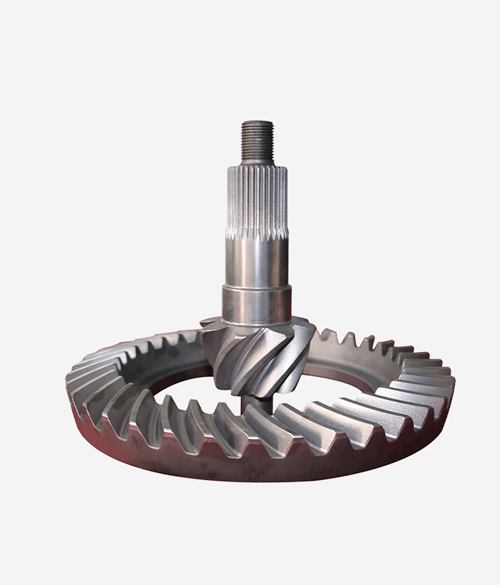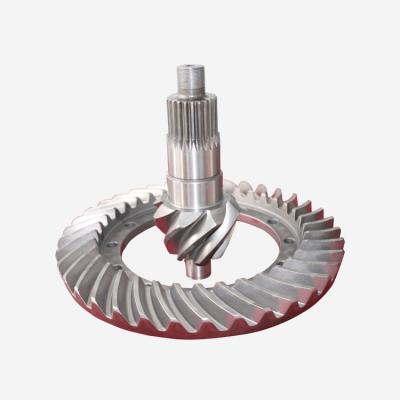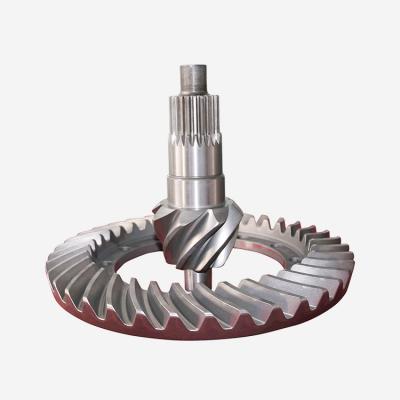What are the influences of driving and driven bevel gear parameters on gear transmission noise?
Selecting the parameters of the active bevel gear is the most important issue in determining the working performance and noise of the gear. The following are the general rules for the selection of relevant parameters in gear design.
1. Modulus and number of teeth
The greater the modulus of the gear, the higher the strength and the less deformation of the teeth in the transmission. Theoretically, the smaller the angular velocity of the gear, the smaller the vibration and noise, but in fact the larger the modulus, the greater the absolute value of the processing error, which increases the transmission load and increases the vibration and noise; at the same time, from the perspective of acoustic theory, the end of the rotating body The larger the area, the greater the noise generated at the same angle. When the number of teeth is determined, increase the modulus, increase the end area, and increase the noise emission capability. On the other hand, gear noise is also related to the linear velocity of the gear joint. The greater the linear speed, the greater the running noise. Relevant tests show that the gear line speed doubles, and the gear noise increases by 6 decibels.
When the modulus is determined, reducing the number of teeth of the gear will reduce the noise, reduce the radiation area of the noise, and reduce the peripheral speed of the gear at the same time, which is beneficial to reduce the gear noise. However, the reduction of the number of teeth is limited by the following two aspects: one is that the number of teeth is too small, and undercutting will occur during gear machining; on the other hand, when the pressure angle is determined, the sum of active and passive teeth is too small to reduce the overlap coefficient, Affects stability and ability to transmit loads. In terms of reducing gear noise, a smaller modulus should be selected on the premise of satisfying the strength; the contact ratio of the active and passive gears is 1.75-2. On the premise of 0, a smaller number of teeth should be selected to obtain a smaller gear diameter. In addition, in the gear transmission, the number of teeth of the main and driven gears should be a prime number to disperse the influence of the tooth contact error on the transmission stability, and some periodic repeated meshing phenomena will not appear in the transmission, eliminating the error caused by the gear transmission Noise caused by periodic forced vibration.
2. The contact ratio and helix angle of the driving bevel gear
The contact ratio of driving and passive gears is generally considered to be an important indicator for evaluating the stability and load-carrying capacity of gear transmission. Increasing the contact ratio can reduce the impact force of the active and passive gears when they are combined and separated, thereby reducing vibration and noise. However, when the corrected contact ratio exceeds 2.3, the durability life under the corresponding stress cannot be guaranteed, especially the impact resistance of the gear is weakened. Increasing the helix angle of the driving bevel gear can increase the contact ratio of the driving and passive gears, because on the basis of ensuring the strength of the driving gear, a slightly larger helix angle should be selected to stabilize the transmission and increase the service life of the gear.
3. The tooth surface width of the driven wheel
In theory, increasing the tooth width can increase the strength and rigidity of the gear, reduce the deformation of the gear teeth during the meshing process, and reduce noise. In the experiment, it is found that the influence of the change of the tooth width on the noise is limited, and the change of the gear noise is small. Therefore, Gleason, which is usually the case in design, recommends a 30% to 33% outer taper distance.
4. The average pressure angle on both sides of the tooth
Increasing the pressure angle can increase the strength of the gear, but when the number of teeth of the driving and driven gears remains the same, increasing the pressure angle will reduce the contact ratio. More importantly, increasing the pressure angle will increase the radial load of the bearing and the bending deformation of the shaft, which will affect the normal meshing of the main and driven gears and cause vibration and noise. Therefore, in order to improve the bearing capacity of the gear, the use of a gear with a large pressure angle does more harm than good. The average pressure angle on both sides of Nissan timber is 22.5°.
5. Backlash
The recommended backlash is as follows,
Modular backlash (mm)
25.50.50-0.75
13.00.30-0.40
8.470.20-0.28
6.350.15-0.20
4.230.1-0.15
2.540.05-0.10
There is a certain side clearance in the processing of hypoid gears, which is determined according to the tooth spacing and working conditions. If the gap between the teeth is too small, it will increase the pressure of the lubricating oil between the teeth, cause elastic vibration, and even damage the oil film on the tooth surface, which may also cause interference on the tooth side. Therefore, within the recommended range, choosing a larger inter-tooth clearance is beneficial to reduce gear noise.
Six, offset distance
Compared with the spiral bevel gear, the main shaft of the hypoid gear and the driven gear shaft have an upward or downward offset, which is the offset distance of the hypoid gear. Increasing the deviation distance can increase the diameter of the driving bevel gear, so that it has good strength and rigidity, and increases the load of the gear transmission. At the same time, a larger helix angle can be selected to increase the contact ratio and reduce transmission noise. However, too large a bias distance will produce root cutting, so the bias distance should be increased without root cutting. The recommended deviation distance is less than 20% of the average cone distance.




